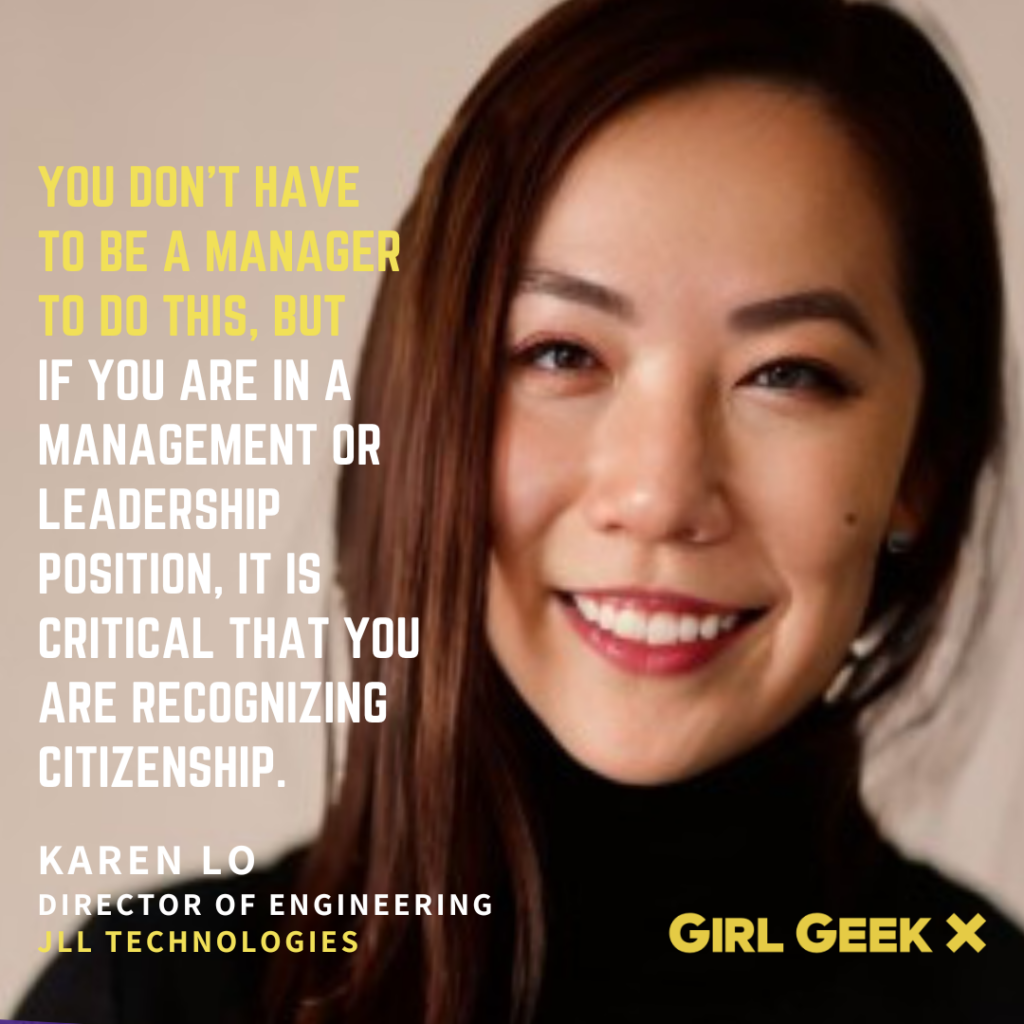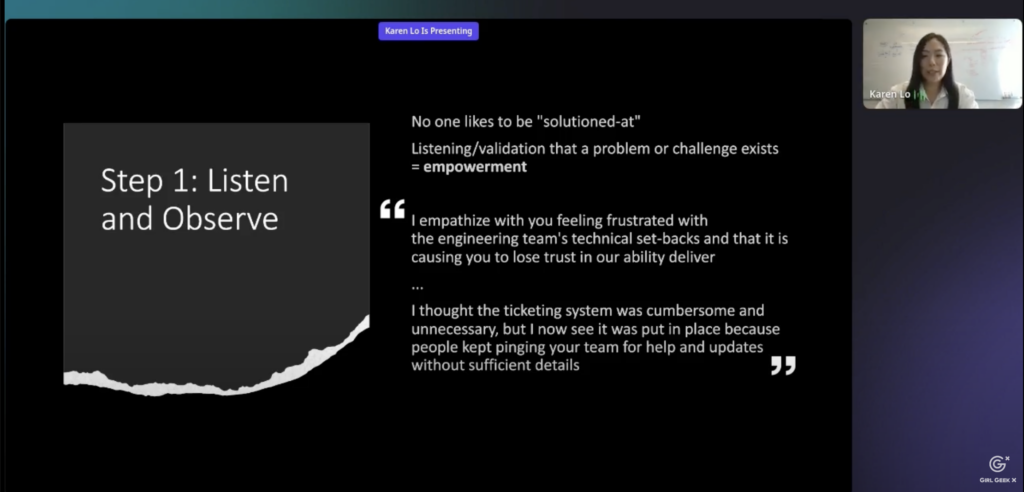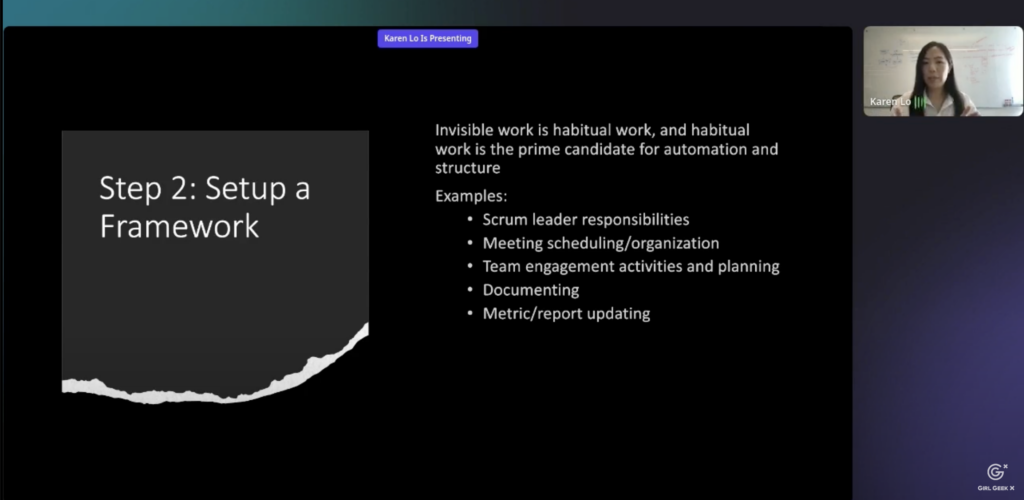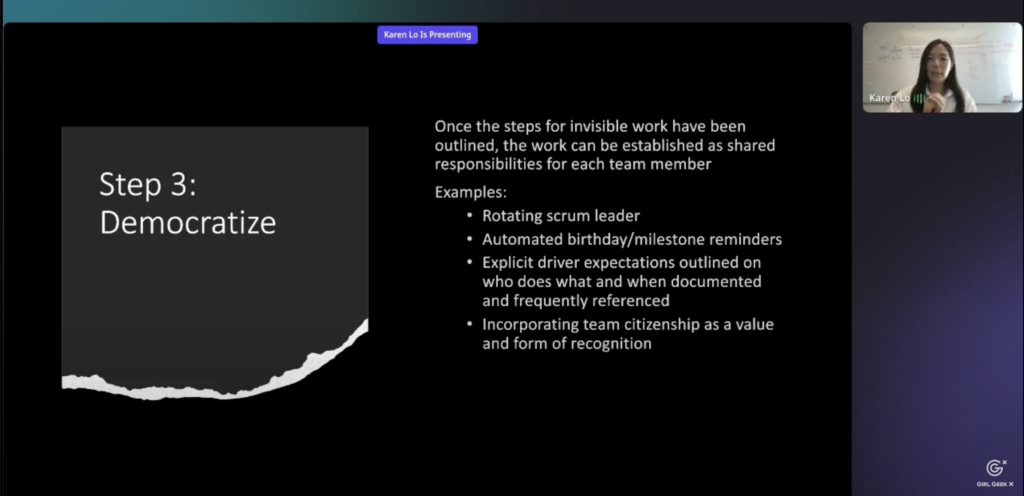VIDEO
In this session, Karen Lo (Director of Engineering at JLLT) will share her experience as a seasoned engineering leader on the playbook for influencing others, from knowing the rules to break the rules, to de-weaponizing incompetence. She will also discuss how to legitimize invisible work. This is a session you won’t want to miss!
Like what you see here? Our mission-aligned Girl Geek X partners are hiring!
- Check out open jobs at our trusted partner companies.
- Watch all ELEVATE 2023 conference video replays!
- Does your company want to sponsor a Girl Geek Dinner or Career Fair? Talk to us!

Angie Chang: With us today, we have Karen, who is a director of engineering at JLL Technologies, where she leads a team of talented engineers, engineering leaders across eight products with an ability to drive innovation and strategic business goals. Prior to JLLT, she was a software engineer at Intuit and Yahoo. And as a seasoned engineering leader, we’re excited to hear about how her experience in web development, machine learning, and data informed her guidance on influencing others and decoding unspoken rules. Excited for this talk. Welcome, Karen.
Karen Lo: Thank you so much, Angie, for the very warm welcome. Hi, everyone. Thank you for tuning in today. I know you’ve got a lot of things that you could be doing, so I appreciate your time today. I will be speaking about Rewriting the Leadership Manual: A Playbook on Influencing for Non-Influencers.
Karen Lo: For this talk, I was inspired by the other woman on my team and wanted to really write down the different things that I learned over the years and how I’ve applied them through every position I’ve had outside of just my management position that have helped me over the years in providing me with an influencing style, whereas I’m typically somebody who’s not really that open spoken or talking about my own promotions, things like that. This is my approach for how I’ve been influencing, and let me go to the next slide.
Karen Lo: Here’s an overview. It will consist of three parts. Part one, learn the rules to break the rules, part two, de-weaponizing incompetence, and part three, legitimizing invisible work. I’ll dive deeply into each of these parts, and please feel free to type in any questions you have so I can answer them later.
Karen Lo: Part one, learn the rules to break the rules. No one likes to be solutioned at. I know that I don’t like to, especially when sometimes I’m just trying to rant about something, whether it’s about a process that’s really annoying or something that seems to be broken from my point of view. And sometimes I just want somebody to listen to me without providing me with solutions.
Karen Lo: I think that this applies to several people, especially when you join a new team, right? You don’t want to be the person who thinks that they know everything already before they’ve actually understood the nuances of each problem. When you listen and observe, which is step one, you are listening and validating that a problem or challenge exists. This in itself is empowerment. If you validate to somebody that, “Hey, I hear you and I totally understand your pain,” sometimes you may not have to agree with it, but just by saying you hear them, that provides a lot of trust that the person will have in you that, hey, you’re actually trying to listen to the problems that they have.
Karen Lo: A couple of examples of how you might see this conversation play out in real life is sometimes you might say something like, “Hey, I empathize with you feeling frustrated with the engineering team’s technical setbacks, and that is causing you to lose trust in our ability to deliver.” Sometimes you’re talking to a product manager or sometimes even a client, and we have engineering setbacks all the time, but it doesn’t mean that people are happy with it. And so you saying that instead of being very defensive about, oh, we have to do this or we have to do that, just acknowledging that goes really far.

Karen Lo: Another example is, “Oh, I thought the ticketing system was really cumbersome and unnecessary, but I now see it was put in place because people kept pinging your team for help and updates without sufficient details.” We all know that context switching is incredibly expensive. And so if a team has put a ticketing process in place and it is annoying to go through, sometimes you just want to see, hey, how did we get there in the first place?
Karen Lo: This is step one, first, listening and observing. Once you’ve listened and you feel comfortable enough to say something, step two is offering intentional support. This is very different than offering support. How many of you have ever found yourself in a position where you yourself have said or someone has said to you, “Hey, let me know if you need anything.” That kind of puts the receiving end in a position where they’re like, “Well, I have to put in extra work to reach out to this person to tell them what I need.”
Karen Lo: A couple of examples for what you can use instead that’ll be more effective are, “Hey, would you mind if I reached out to my leadership team about this? I think they’ll be able to help, and I’ll CC you in the email.” Or, “How about I take this off your plate?” Or, “I know a person who can help. Let me start a group chat.” Or, “I’ve faced a similar issue. Let me send you the documentation on how to fix it.” Each of these things are very intentional in you actually recommending a path forward and providing them with just a yes/no instead of, “Hey, tell me whatever you want under the sun,” because that is probably not going to happen and they’re probably not going to ask you for help.
Karen Lo: Part two, once you’ve listened and you’ve gained some credibility, the second part is to de-weaponize incompetence. I know this has many charged words, de-weaponizing and incompetence, but how many of you have ever been in a position where you’ve done something because you were either faster at it, you could do it faster, someone else asked you to do it because you were better at it, or you were maybe somebody who did it more thoroughly? Sometimes people are like, “Hey, can you do this? You tend to be a lot better at it than I am.”
Karen Lo: These are signs that I’m just sharing on how to be mindful of when you see this happening. Because while not all requests are inherently bad, sometimes you’re asked to perform a task that you may not really feel like you should be the one doing, but then you find yourself gaslighting yourself by saying, “Oh, well, that engineer or that manager is too busy. I guess I’m the only one who could do it.” Or for example, am I being asked…
Karen Lo: These are the different ways, I guess, to pinpoint if this is happening to you. First one is, am I being asked to do something purely because I’m better or faster at it? Am I being asked to undermine a process for someone else’s convenience? Is someone asking for help but expecting me to do the bulk of the work? Or is someone using urgency or impending deadlines to convince me to do something that could otherwise be done by someone else?
Karen Lo: Step one, identifying when you’re being put in a position where someone may be using incompetence to get you to do something, whether or not it’s intentional or not, right? Some people, that’s just the way that they operate and it’s not really meant to be hurting you or anything, but you need to identify if you think you’re being hurt by it and being put in a position where you’re doing work that you think could be done by other people or that person themselves. So remember, we’re all data-driven people here, so no need to use data to gaslight yourself too.
Karen Lo: Once you’ve identified if you’re in that position, step two is mitigating. Once you have that in mind, you’re like, “Okay, what can I do now?” You control the precedent that you set. You give yourself a choice. In a lot of these positions, when I’ve been part of situations like this, I typically think to myself, “Oh, I don’t have a choice,” or, “Oh, I have to do it.” Which sometimes you accept that you have to do it, but sometimes you don’t.
Karen Lo: A couple of ways that you might be able to mitigate the situation is you can say something like, “Hey, I appreciate that you think I’m someone who’s much better at this, but let’s spend some time for me to watch and provide some feedback as you go through the steps so you also become proficient.” This puts them in the position where they’re actually doing the work and you’re just providing feedback so that they become better at it. And that way in the future, it’s less likely that they will say something like, “Hey, can you just do this? You’re a lot better at it.”
Karen Lo: Second way is, “I understand the urgency of this request. However, I want you to be aware that if we bypass the existing processes to release sooner, we risk breaking core functionality and need to perform an emergency rollback. But I’m happy to oblige if you are willing to accept that risk.” Instead of saying, “Hey, I didn’t have a choice. That director asked me to release this right now and bypass going through QA or going through our regular things.”
Karen Lo: At the end of the day, you’re the one who signed off on doing this thing and you’re the one who actually executed it. Instead of saying that you don’t have a choice, you reflect this back at the requester. And when you reflect the responsibility back at the requester, they need to provide you with an official sign-off on the thing that they’re asking you to do because then you will truly be giving them the option to do it or not and not feeling like you yourself had to break rules in order to accomplish something for someone else.
Karen Lo: One more example is, “Hey, let’s discuss with our manager PM to see what the urgency and priority is. I have work on my plate that will be dropped if I need to jump on the task you’re requesting help with.” This is probably a very common scenario in which you might get pinged by somebody else, or maybe your PM themselves will ask you, “Hey, can you jump on this very urgent bug or deliver on this feature by the end of the week?”
Karen Lo: Well, you can reflect that back to them and say, “All right, I will do it. But just to let you know, I’m working on this thing that we discussed at the beginning of the sprint, and that for sure will slip. Is that the choice you want me to make?” And that way they have to think about what the prioritization is and you do not drop it and then have repercussions at the end when maybe you ended up not delivering on the initial work that you had signed up for at the beginning of the sprint. All right, so that was part two.
Karen Lo: Part three is legitimizing invisible work. What exactly is invisible work? I think a lot of us have done this type of work before. Invisible work is generally very habitual work that we do. Maybe it’s setting up meetings, writing documentation, taking notes to send for a meeting afterwards, remembering people’s birthdays, and celebrating milestones. I don’t know if that sounds familiar to you, but those are a lot of things that I personally have done that felt invisible.
Karen Lo: The first step to legitimize that type of thing is we want to cascade the recognition. Instead of you saying, “Hey, I’m doing all this stuff, guys. I should be recognized for it.” It’s much more about being intentional about who you recognize, how you recognize them, and just being present in being aware that someone did something that maybe went above and beyond, or they did exactly what was within their job description, but they did it really well.
Karen Lo: When you create a feedback loop that takes away pressure to self-promote, you promote other people to start doing the same thing. An example is maybe you’re sending an email to a person that you enjoyed working with, or sorry, maybe you really enjoyed working with somebody. You send an email to their manager, your manager, letting them know about this positive experience you had and how the person assigned helped you accomplish your tasks. Stuff like this that’s day- to-day, they generally are not recognized, but I don’t think there’s any harm in just saying, “Hey, thanks so much for helping me with this request. I know you guys are swamped with a lot of things, but just by the way, I don’t know if you even realize how important it was for me, but this helped me unblock my deployment. And normally, I’m waiting two weeks back and forth.” Something like that, it goes a long way.
Karen Lo: Another way you can do this is privately pinging a person in leadership or maybe even a peer to suggest that they provide recognition for this person because you think that it’s important that they know that this person either helped to go through an architectural review for the first time when the company is trying to make that more standardized. Maybe they did something really well. Maybe they performed their on-call duties really well and the incident management team would love to know that.
Karen Lo: You are just directing the people who might care about it and you’re surfacing what you want to talk about and recognize them for, but you’re not doing it yourself. You’re asking someone else to do it. And generally they’ll probably say, “Oh yeah, I would love to recognize this person.” Or even just give a quick shout-out or send an email just to let broadly more people know about the work that this person did.
Karen Lo: And step two is setting up a framework. Like I mentioned before, invisible work is generally habitual work. And habitual work is the prime candidate for automation and structure because we know that if you’re going to be repeating the same thing over and over, why not make life a little bit easier for not just yourself but everyone else?

Karen Lo: First thing that goes into this is to set up the framework. What does it look like if you were to repeat this task and be able to share it across not just your team, but maybe other teams as well? Because remember, a framework is something that is repeatable structure-wise, but not all the steps in a framework need to be the same. So they can always be adapted to fit any other use case.
Karen Lo: Some prime examples of how you might set up, or what you might set up a framework for are scrum leader responsibilities, maybe meeting scheduling, team engagement activities, documenting, metric reporting. All of these things you can put together, hey, as a scrum leader, every week you have stand-ups that you run, grooming sessions, sprint planning, retros, sprint review. These are all very straightforward things that every time you’re a scrum leader, you’re probably going to be doing these things.
Karen Lo: Something like team engagement activities and planning, why don’t you just have everybody put in their birthdays and then maybe integrate with a Slack bot so that it reminds everyone when it’s their birthdays. Things like that are prime examples of how you can set up a framework. And of course, there’s many other ways you can do it, but these are just some examples for you to look at.

Karen Lo: The last step of this playbook for part three is to democratize that. Now that you have the invisible work lined out step by step, it is something that you don’t have to do by yourself anymore. Once you have that together, you can then set up a meeting and say, “Hey everyone, here’s a framework I put together for what you would do as a scrum leader. It would be really great if we each owned, every one of us owned the scrum process because this is for us and this is for our team. I’ve laid it out really simply so that you just need to follow these things and then this is the way that you lead them. And I can definitely provide some feedback along the way. I’m not going anywhere, but I want this to become something that is a shared responsibility.” And like I mentioned earlier, automated birthday milestone reminders.
Karen Lo: Third one is to have explicit driver expectations outlined on who does what and when documented and frequently referenced. And I say frequently referenced because we all know we write documentation that goes into the abyss and no one ever reads it ever again. The framework type of documentation is what I would generally expect drivers to frequently reference until they forget about what is expected of me and they just know, and then they share it with anyone else who joins the team because then those people will also be taking on the responsibility.
Karen Lo: And finally, we want to incorporate team citizenship as a value and form of recognition. You don’t have to be a manager to do this, but if you are in a management or leadership position, it is critical that you are recognizing citizenship. Because it’s so easy for us to get bogged down by the day-to-day things of we’re coding or we’re going to meetings about things and we’re creating pull requests. And we know what our work is. But the part that’s important is the way that we interact with each other. That doesn’t always get intentionally highlighted.
Karen Lo: Intentionally highlighting, “Hey, thanks so much for replying back to me so quickly.” Or, oh, so-and-so, I was running into an issue and they were like, “Why don’t we hop on a chat and I’ll walk you through this thing?” And it just goes a really long way to providing a very healthy culture in which people start to be a lot more mindful about the things that they recognize each other for. And then they’re more aware of what they’re doing so that they can share the love with everybody else. And eventually you create a culture in which people recognize each other without needing to prompt for, “Hey, you should probably recognize that person,” into your culture.”
Karen Lo: That’s pretty much in a nutshell three parts for how I have learned to influence over the years. I hope that this has provided everyone with at least some nuggets of knowledge. Again, thank you so much for joining me today. I know you guys are busy, so have a great rest of your day.
Angie Chang: Thank you, Karen. I know you wanted to share your slides. If you could do that on LinkedIn or whatever social network that you prefer, we can reshare it and people can save it and look at it for themselves. You can always replay this as well. Thank you so much for joining us, and we’ll be hopping to our next session.
Like what you see here? Our mission-aligned Girl Geek X partners are hiring!
- Check out open jobs at our trusted partner companies.
- Watch all ELEVATE 2023 conference video replays!
- Does your company want to sponsor a Girl Geek Dinner or Career Fair? Talk to us!


